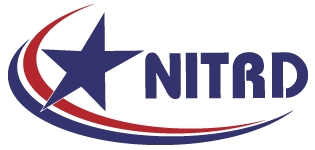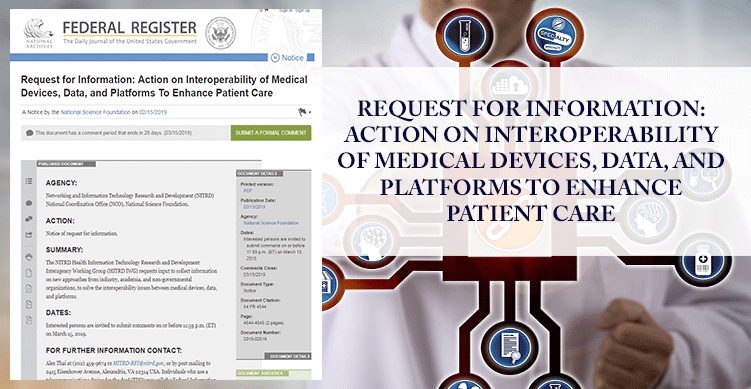Federal Register Notice: 84 FR 4544
AGENCY:
Networking and Information Technology Research and Development (NITRD) National Coordination Office (NCO), National Science Foundation.
ACTION:
Notice of request for information.
SUMMARY:
The NITRD Health Information Technology Research and Development Interagency Working Group (HITRD IWG) requests input to collect information on new approaches from industry, academia, and non-governmental organizations, to solve the interoperability issues between medical devices, data, and platforms.
DATES:
Interested persons are invited to submit comments on or before 11:59 p.m. (ET) on March 15, 2019.
FOR FURTHER INFORMATION CONTACT:
Alex Thai at (202) 459-9674 or HITRD-RFI@nitrd.gov, or by post mailing to 2415 Eisenhower Avenue, Alexandria, VA 22314 USA. Individuals who use a telecommunications device for the deaf (TDD) may call the Federal Information Relay Service (FIRS) at 1-800-877-8339 between 8 a.m. and 8 p.m., Eastern time, Monday through Friday.
ADDRESSES:
Comments submitted in response to this notice may be sent by any of the following methods:
Email: HITRD-RFI@nitrd.gov. Email submissions should be machine-readable and not be copy-protected. Submission should include “RFI Response: Action on Interoperability of Medical Devices, Data, and Platforms to Enhance Patient Care” in the subject line of the message.
Fax: (202) 459-9673, Attn: Alex Thai; or
Mail: Attn: Alex Thai, NCO, 2415 Eisenhower Avenue, Alexandria, VA 22314 USA.
SUPPLEMENTARY INFORMATION:
Purpose: There is ongoing recognition that medical device interoperability is an issue and has a documented impact on patient care and safety. These issues persist despite previous government efforts by the Food and Drug Administration, the Department of Defense, the Veterans Administration, the National Institute of Standards and Technology, the National Institutes of Health, and the National Science Foundation. The goal of this effort is to determine whether a vision of sustained interoperability in the hospital and into the community is feasible and, if so, what it will take to realize it. In addition, this RFI looks to examine how users might leverage the existing tools and processes for implementing this shared future vision. Please address the following in your response.
(1) What is your vision for addressing interoperability issues between medical devices, data, and platforms? How would this plan to create interoperable systems address your key use cases and pain points?
(2) Who are the relevant parties and their contributions to your interoperability solution?
(3) What are the challenges and impediments to making interoperability happen? How might these issues be addressed and by whom?
(4) Is the federal vision for a medical device, data, and platform interoperability end state outlined in this RFI viable? Please explain why you have reached the conclusion that you have.
Instructions: Response to this RFI is voluntary. Each individual or institution is requested to submit only one response. Submissions must not exceed 20 pages in 12 point or larger font, with a page number provided on each page. Responses should include the following: Name of the individual(s) or organization(s) filing the comment; a description of the individual(s) or organization(s) mission and/or expertise; non-proprietary public-private partnership work within the past three years with Federal, State, or local governments that is relevant to applied research on interoperability on data, platforms, and medical devices; and an Executive Summary for comments exceeding 15 pages.
Responses to this RFI may be posted online at http://www.nitrd.gov. Please do not include any confidential, proprietary, or sensitive information that you do not wish to be made public. Submissions are subject to the Freedom of Information Act (FOIA).
In accordance with FAR 15.202(3), responses to this notice are not offers and cannot be accepted by the Government to form a binding contract. Responders are solely responsible for all expenses associated with responding to this RFI.
Overview: Medical devices, electronic health records, and the data generated and stored in these systems are essential to the practice and advancement of modern medicine and healthcare. While healthcare systems are rife with medical devices and the data they produce, to date, these devices are not interoperable and cannot effectively interact with each other and the broader healthcare ecosystem. With interoperability Start Printed Page 4545between medical devices and systems enabled, new models for monitoring, device interaction, and control—including the development of closed loop, autonomous and semiautonomous systems—can be realized. These new models will provide greater support for patient safety, decrease medical errors, reduce provider burden, reduce practice variability across healthcare facilities/geographic areas and, ultimately, will enhance medical care quality and outcomes.
Future Vision: When people with serious injuries or illness are hospitalized medical device additions and changes are automatically recorded with no deficit in patient safety, loss in data fidelity, or data security as the patient transitions across the continuum of care. Additional medical devices can be added or removed as the patient’s status changes and details of these changes, calibration of the instruments, and each equipment’s unique device identifier [UDI] and configuration settings are recorded and synchronized. If a piece of equipment breaks, it can be switched seamlessly with a device from another vendor. Data and settings from patient medical devices, such as insulin pumps, are identified, integrated, and time synchronized, and select data are included in the electronic health record. As autonomous capabilities are added, real-time care is logged, and supervisory control established to ensure the provision of real-time patient monitoring and support. When providers are not available, or have competing demands, medical devices will function in a closed loop, autonomous manner with appropriate safety and control measures to stabilize the patient. Data will flow through changes in equipment that occur in moves from the emergency room, to the operating room, to the intensive care unit, to a rehabilitation facility, and finally to the home. This will allow for data and metadata to flow even as changes in equipment are mapped to individual patient needs and environment. Each change in equipment configuration will be noted in the supervisory system/medical record and in the metadata (e.g., the UDI) generated by the device. The resulting patient record from these systems will include device data, metadata, and care documentation. These patient records can be stored and analyzed using medical black box recorder-equivalents to assess adverse events or examine unexpected positive outcomes. This will also improve the consistency and quality of care; create real-time automated care systems; create a learning health system.
These types of records and the real-time systems interactions they enable are widely used or are being actively developed in other industries, such as the industrial controls and autonomous systems in the automotive, aviation, and energy sectors. That is not the case for healthcare. While there are many factors that may inhibit real-time interaction in a medical setting, interoperability solutions that are relevant for healthcare and patient safety need to be developed. Seamlessly flowing, interoperable data from medical devices and systems, when utilized effectively, could significantly enhance patient outcomes, identify and reduce errors, enhance the efficiency of care delivery, reduce development times and costs, improve standardization/consistency of care delivery, and decrease healthcare provider burnout.
Next Steps: The Government anticipates hosting a conference in June/July 2019 to allow for additional engagement. The results of the conference discussion, in addition to the written responses to this RFI, will be used to determine next steps in addressing federal efforts in interoperability of data, platforms, and medical devices. This RFI is solely issued to engage with interested parties to inform the Government on developing a strategy for medical device, data, and platform interoperability. The Government will not reimburse costs associated with participating in the conference. The Government may contact respondents regarding their submissions, such as to ask questions, to learn more, or to notify them of further developments related to the effort.
Submitted by the National Science Foundation in support of the Networking and Information Technology Research and Development (NITRD) National Coordination Office (NCO) on February 11, 2019.
Suzanne H. Plimpton,
Reports Clearance Officer, National Science Foundation.
[FR Doc. 2019-02519 Filed 2-14-19; 8:45 am]
BILLING CODE 7555-01-P


